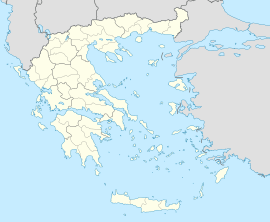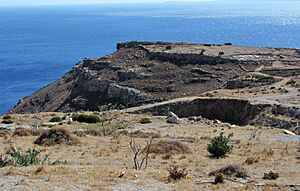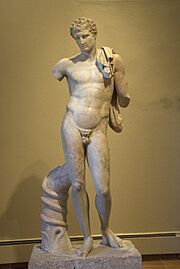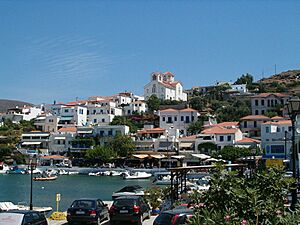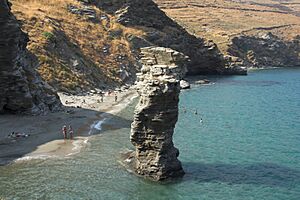Andros facts for kids
Quick facts for kids
Andros
Περιφερειακή ενότητα / Δήμος
Άνδρου |
|
|---|---|
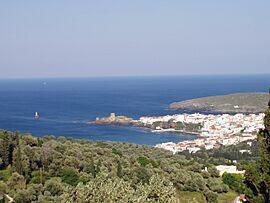
Andros town
|
|
| Country | Greece |
| Administrative region | South Aegean |
| Area | |
| • Total | 380 km2 (150 sq mi) |
| Population
(2021)
|
|
| • Total | 8,826 |
| • Density | 23.23/km2 (60.2/sq mi) |
| Time zone | UTC+2 (EET) |
| • Summer (DST) | UTC+3 (EEST) |
| Postal code |
845 xx
|
| Area code(s) | 22820 |
| Vehicle registration | EM |
Andros (Greek: Άνδρος) is the northernmost island of the Greek Cyclades archipelago. It is located about 10 kilometers (6 miles) southeast of Euboea and 3 kilometers (2 miles) north of Tinos. The island is nearly 40 kilometers (25 miles) long and its widest part is 16 kilometers (10 miles).
Andros is mostly mountainous, but it also has many fertile and well-watered valleys. The total area of the municipality, which includes Andros island and a few small, uninhabited islands, is 380 square kilometers (147 square miles). The largest towns on the island are Andros (town), Gavrio, Batsi, and Ormos Korthiou.
Palaeopolis, the ancient capital, was built on a steep hillside. You can still see the breakwater of its old harbor underwater. In the village of Apoikia, there is a special spring called Sariza. Its water flows from a stone lion's head sculpture. Andros is also a great place for hiking, with many new paths being added regularly.
Contents
Ancient Settlements
Strofilas: A Neolithic Village
During the late Neolithic period (around 4500–4000 BC), Andros had a fortified village on its west coast. Archaeologists named it Strofilas, after the flat area where it was built. This settlement is linked to the "Attica-Kephala" culture, which was at the start of the Cycladic culture of the Bronze Age.
Strofilas is the largest organized Neolithic settlement found in the Aegean Sea's Cyclades islands. It was built very close together and covered over 30 acres. Greek archaeologists began excavating it in 1997.
This settlement was an important maritime center and one of the earliest examples of a fortified town in Greece. Its defenses included a gate and strong towers called bastions. Strofilas is also famous for its rock carvings on the walls. These carvings show animals like jackals, goats, deer, fish, and dolphins. There is even a picture of a group of ships.
Zagora: A Later Ancient Town
About 1 kilometer (0.6 miles) southeast along the coast, you can find another ancient settlement called Zagora. This town dates back to the 10th-8th centuries BC, during the Geometric period. A very strong wall, about 110 meters (360 feet) long, was built around it.
History of Andros
Andros in Ancient Times
In ancient times, people from Ionia lived on Andros, possibly mixed with people from Thrace. By the 7th century BC, Andros became rich enough to send people to start new towns, called colonies. These colonies were in Chalcidice, including places like Acanthus and Stageira.
The ruins of Palaeopolis, the ancient capital, are on the west coast. This town had a famous temple dedicated to Dionysus, the god of wine. In 480 BC, Andros provided ships to the Persian king Xerxes I. Because of this, the Greek fleet later attacked the island.
Andros was part of the Delian League, a group of Greek city-states led by Athens. However, Andros often disagreed with Athens. In 477 BC, Athens had to send settlers to the island to control it. Still, in 411 BC, Andros declared its freedom and fought off an Athenian attack in 408 BC.
During the Hellenistic period, Andros was important because of its location. Two strong naval powers, Macedon and Ptolemaic Egypt, often fought over it. In 200 BC, a combined fleet from Rome, Pergamum, and Rhodes captured Andros. It then became part of the Pergamene kingdom until 133 BC, when it was given to Rome.
Andros in the Middle Ages
During the many centuries of Byzantine rule, Andros was not very well known. It was part of the Byzantine province of the Islands. Like other Aegean islands, it faced raids from Saracen pirates. However, during the Komnenian period (a time in Byzantine history), the island became prosperous because of its silk production. Andros exported fine silk fabrics to Western Europe.
In 1203, Andros was captured by the Fourth Crusade on their way to Constantinople. After Constantinople fell in 1204, the island was supposed to go to the Republic of Venice. In 1207, it became part of the Duchy of the Archipelago under Marco I Sanudo. Over the next centuries, different noble families and powers, including Venice and Genoa, fought for control of Andros.

Andros suffered from attacks by the Ottomans. In 1416, the island was raided, and almost everyone was taken away by the Ottomans. Around the same time, Albanians crossed from Euboea and settled in the northern part of the island. Despite these challenges, Andros and Paros remained the most successful islands in the Cyclades during this time.
In 1537, the Ottoman admiral Hayreddin Barbarossa seized the island. However, the local ruler managed to get it back with help from the French ambassador, by agreeing to pay a yearly tribute to the Ottomans.
Ottoman Rule and Modern Times
When the Ottomans took over Naxos in 1566, the people of Andros also decided to rise up against their ruler. Andros then came under direct Ottoman control. For the next thirteen years, the islands were given to the Sultan's favorite, Joseph Nasi, who used them to gain wealth.
After Nasi's death, the people of Andros and Naxos asked the Sultan to bring back their old ruling families as Turkish vassals. However, the islands were directly added as a province. In 1580, the Cyclades were given special rights, including a lot of local freedom, low taxes, and religious freedom. This situation continued throughout the Ottoman rule. In the early 1770s, during a war between Russia and Turkey, the Russians occupied Andros and used it as a base.
Modern Period
On May 10, 1821, Theophilos Kairis, an important Greek thinker, declared that Andros would join the Greek War of Independence. He raised the Greek flag at the Church of St George. He gave a powerful speech that inspired shipowners and merchants to donate money to build a Greek Navy to fight the Ottomans. After the war, Andros became part of the independent Kingdom of Greece.
After Greece gained independence, Andros became a major center for Greek shipping. This was helped by refugees from Psara and the decline of other shipping centers. Andrian merchants were especially active in the grain trade from the Danube river. At first, Andrian ships were built locally, but later they were built in Syros, especially as ships started using steam power. By 1914, Andrian-registered ships were second in Greece in terms of how much cargo they could carry.
After World War I, the number of local registered ships grew from 25 in 1921 to 80 before World War II. However, the losses during World War II, along with shipping becoming more global and ship-owning families moving to Piraeus and London, marked the end of Andrian shipping.
Administration
Andros is a separate regional unit within the South Aegean region. It is the only municipality in this regional unit. As part of a government reform in 2011, the regional unit of Andros was created. The current municipality of Andros was formed by combining three former municipalities:
- Andros (town)
- Korthio
- Ydrousa
Former Province
The province of Andros was one of the provinces of the Cyclades Prefecture. Its area was the same as the current regional unit of Andros. This province was officially ended in 2006.
Population and Communities
In 1900, the capital town of Andros had about 2,000 people, and the whole island had about 18,000. By the 1991 census, this number had dropped to 8,781. According to the 2011 Greek census, the town of Andros still had 1,665 residents, and the island's total population was 9,221.
The island is divided into three municipal units: Andros (town) (with 3,901 people), Korthio (with 1,948 people), and Ydrousa (with 3,372 people). The northern part of Andros has a small community of Arvanite people. The name of the island in Arvanitika is Ëndra.
Communities and Settlements
- Aladinon
- Apoikia
- Ammolochos
- Andros (Chora)
- Ano Aprovato
- Ano Gavrio
- Arnas
- Batsi
- Epano Fellos
- Gavrio
- Gides
- Kalyvari
- Kaparia
- Katakilo
- Kipri
- Kochylos
- Lamira
- Livadia
- Makrotantalo
- Mermingies
- Mesaria
- Ormos Korthiou
- Palaiokastro
- Palaiopolis
- Piso Meria
- Pitrofos
- Sineti
- Stenies
- Varidio
- Vitalio
- Vouni
- Vourkoti
- Ypsilou
- Zaganiaris
- Strapouries
Tourism
One famous beach in Andros is Pidima tis grias, which means "Jump of the old woman." It gets its name from a legend about an old woman. The story says she betrayed a nearby town to Saracen pirates. After that, she jumped off a cliff to her death and turned into a unique vertical rock formation that stands out at the beach.
Cinema
- Girls in the Sun
- Little England
Notable People
- Amphis (4th century BC), a writer of funny plays.
- Theophilos Kairis (1784–1853), a famous scholar, teacher, priest, and revolutionary.
- Alexander Pantages (1875–1936), an American businessman who owned many theaters.
- Nikitas Kaklamanis (born 1946), a doctor and politician who was once the mayor of Athens.
Gallery
See Also
 In Spanish: Andros para niños
In Spanish: Andros para niños


